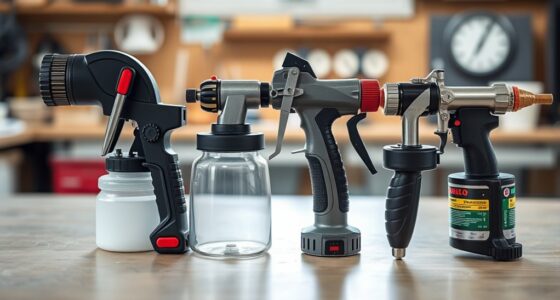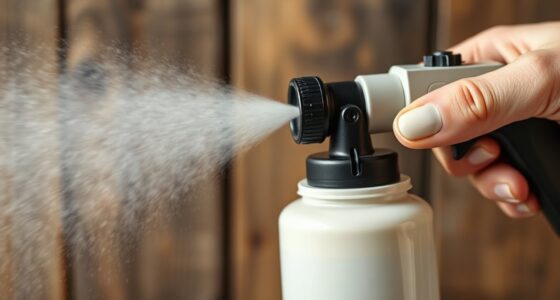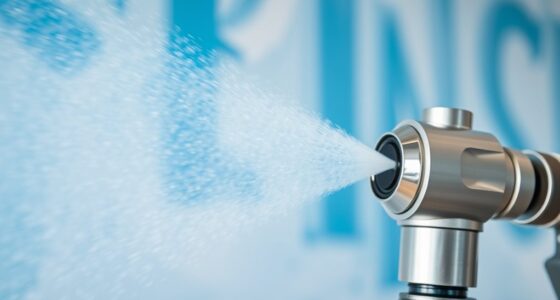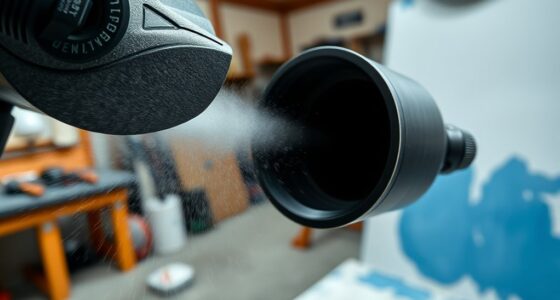Using a paint sprayer can be messy if you don’t take proper precautions, but you can minimize overspray with the right techniques. Wear protective gear like goggles and masks to stay safe, and use painter’s tape and drop cloths to shield non-target areas. Keep the spray gun about 12 inches from the surface and use steady, smooth strokes. Controlling your movements and equipment settings makes a big difference—learn more tips to keep your project neat.
Key Takeaways
- Proper surface preparation and masking prevent overspray from reaching unintended areas.
- Maintaining correct equipment distance (around 12 inches) ensures even coverage and reduces excess spray.
- Using protective barriers like painter’s tape and drop cloths minimizes mess on surrounding surfaces.
- Controlled, steady movement and consistent speed help prevent overspray and uneven application.
- Regularly cleaning and maintaining spray equipment avoids nozzle clogs that can cause erratic spray patterns.
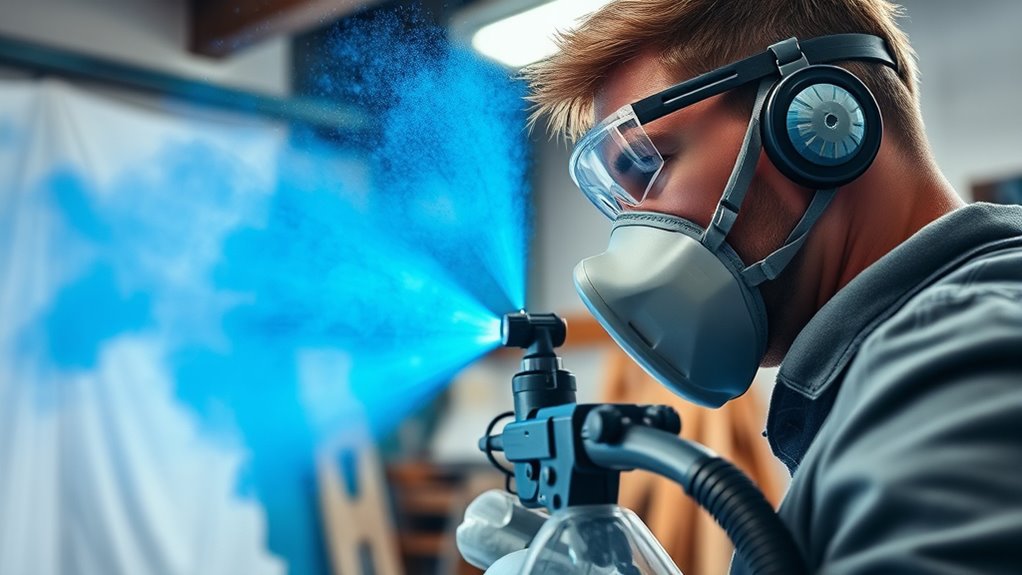
Using a paint sprayer can quickly transform a space, but it often comes with a messy aftermath that can be frustrating to clean up. One of the biggest challenges is managing overspray, which can settle on surfaces far beyond your intended area. To keep the mess to a minimum, you need to approach the job with the right preparation and techniques. Start by wearing proper protective gear, including goggles, a mask, and coveralls. Not only will this keep you safe from paint fumes and splatters, but it also helps prevent accidental contact with paint. When you’re suited up, you’re more likely to stay focused on your spraying technique and less distracted by potential messes.
Wearing protective gear ensures safety and helps you stay focused, minimizing mess and accidents during spray painting.
Before you begin, consider the importance of brush cleaning. Although a sprayer is faster, it can clog or become difficult to clean if paint dries inside the nozzle or hose. Regularly cleaning your spray equipment during breaks keeps it functioning smoothly and reduces the risk of uneven spray patterns, which can lead to excess overspray. Keep a dedicated brush cleaning kit nearby, with brushes, cleaning solvents, and rags. Using a brush to touch up edges or corners after spraying can also help reduce overspray in areas where precision is critical. This way, you can control the final look without over-applying paint with the sprayer.
Positioning your sprayer correctly is key to minimizing overspray. Keep the spray gun at a consistent distance from the surface—usually about 12 inches—and maintain steady, even strokes. Overreaching or moving too fast can cause uneven coverage and more overspray. Practice on a scrap piece first to get a feel for the spray pattern and adjust your settings accordingly. Use painter’s tape and drop cloths to protect surfaces and floors, and consider masking off areas you don’t want painted. These barriers act as a physical shield, reducing the chance of overspray reaching unintended spots.
In addition, controlling your breathing and movement helps keep the spray controlled and precise. Breathe steadily and move your arm smoothly rather than jerking or rushing. Consistent speed and distance from the surface lead to cleaner results and less paint drifting where it shouldn’t. Remember, although a paint sprayer is designed for efficiency, patience and preparation are essential. Proper protective gear, diligent brush cleaning, and careful technique all work together to keep your project neat and manageable. With these strategies, you’ll enjoy the benefits of a sprayer without the headache of a big cleanup afterward.
Frequently Asked Questions
Can Paint Sprayers Be Used Indoors Without Making a Mess?
You can definitely use a paint sprayer indoors without making a mess if you control paint thickness and guarantee proper equipment calibration. Keep the spray at the right distance, use drop cloths and masking tape, and adjust the pressure to minimize overspray. Properly calibrate your equipment beforehand to achieve even coverage, and work in well-ventilated areas. These steps help you keep your indoor space clean while getting professional-looking results.
What Safety Gear Is Recommended to Reduce Overspray?
To reduce overspray when using a paint sprayer, you should wear the right safety gear. Protective gear like goggles and coveralls shield your skin and eyes from paint particles. Respirator masks are essential to filter out fumes and prevent inhalation of fine overspray. Always guarantee your gear fits properly and is rated for paint fumes. This way, you stay safe and keep your workspace cleaner.
How Long Does It Take to Clean a Paint Sprayer Thoroughly?
Cleaning a paint sprayer thoroughly depends on your specific model and the complexity of the cleaning process. Typically, the time estimate ranges from 15 to 30 minutes. You’ll want to disassemble the parts, flush out residual paint, and clean all components carefully. Taking your time ensures the sprayer functions well for future projects. Remember, a thorough cleaning prevents clogs and maintains peak performance.
Are There Specific Paint Types Better Suited for Spray Application?
You might think all paints work equally well with spray application, but specific types greatly enhance spray efficiency and paint compatibility. Oil-based paints are thicker and can clog sprayers, while latex or acrylic paints spray smoothly and reduce overspray. Using the right paint guarantees a cleaner, more efficient job, minimizing mess and overspray. Always check the manufacturer’s recommendations to match your spray system with the appropriate paint type.
How Does Room Size Affect Overspray and Cleanup?
Room size greatly impacts overspray and cleanup when using a paint sprayer. Larger room dimensions mean more surface area, increasing the chance of overspray spreading beyond your target. Good ventilation efficiency helps contain overspray and reduces airborne paint particles, making cleanup easier. In smaller rooms, overspray is more concentrated, so you need to take extra precautions like masking nearby surfaces and ensuring proper ventilation to keep the mess minimal.
Conclusion
So, steering clear of splatters and splashes takes some skill, but it’s definitely doable. With careful control, consistent coverage, and clever cleanup, you can conquer the chaos of a messy paint sprayer. Remember, practice prevents paint from pouring past boundaries, turning your project into a pristine masterpiece. Stay steady, focus fine-tuning your technique, and soon, you’ll enjoy a flawless finish free of fuss and filth. Painting perfection is perfectly possible—just stay patient and prepared!


